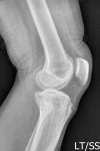Apophysitis of the Tibial Tuberosity (Osgood-Schlatter Disease): A Review
- PMID: 27752406
- PMCID: PMC5063719
- DOI: 10.7759/cureus.780
Apophysitis of the Tibial Tuberosity (Osgood-Schlatter Disease): A Review
Abstract
Osgood-Schlatter disease (OSD) is a condition in which the patellar tendon insertion on the tibial tuberosity becomes inflamed. It is a well-known condition in late childhood characterized by pain and a bony prominence over the tibial tuberosity. The pain is usually exacerbated by physical activities like running, jumping, and climbing stairs. In the acute stage, the margins of the patellar tendon become blurred in radiographs due to the soft tissue swelling. After three to four months, bone fragmentation at the tibial tuberosity is viewed. In the sub-acute stage, soft tissue swelling resolves, but the bony ossicle remains. In the chronic stage, the bone fragment may fuse with the tibial tuberosity which can appear normal. The primary goal in the treatment of OSD is the reduction of pain and swelling over the tibial tuberosity. The patient should limit physical activities until the symptoms are resolved. In some cases, the patient should restrict physical activities for several months. The presence of pain with kneeling because of an ossicle that does not respond to conservative measures is the indication for surgery. In these cases, the removal of the ossicle, surrounding bursa, and the bony prominence is the treatment of choice.
Keywords: apophysitis; osgood-schlatter disease; tibial tuberosity.
Conflict of interest statement
The authors have declared that no competing interests exist.
Figures




References
-
- Osteochondritis dissecans of the knee: pathoanatomy, epidemiology, and diagnosis. Grimm NL, Weiss JM, Kessler JI, et al. http://www.whonamedit.com/synd.cfm/1711.html. Clin Sports Med. 2014;33(2):181–188. - PubMed
-
- Hyphenated history: Osgood-Schlatter disease. Nowinski RJ, Mehlman CT. Am J Orthop (Belle Mead NJ) 1998;27(8):584–585. - PubMed
-
- Osgood Schlatter syndrome. Gholve PA, Scher DM, Khakharia S, et al. http://journals.lww.com/co-pediatrics/Abstract/2007/02000/Osgood_Schlatt.... Curr Opin Pediatr. 2007;19(1):44–50. - PubMed
-
- The so-called unresolved Osgood-Schlatter lesion: a concept based on fifteen surgically treated lesions. Mital MA, Matza RA, Cohen J. J Bone Joint Surg Am. 1980;62(5):732–739. - PubMed
-
- Tibial tuberosity excision for symptomatic Osgood-Schlatter disease. Flowers MJ, Bhadreshwar DR. J Pediatr Orthop. 1995;15(3):292–297. - PubMed
Publication types
LinkOut - more resources
Full Text Sources
Other Literature Sources
Medical
